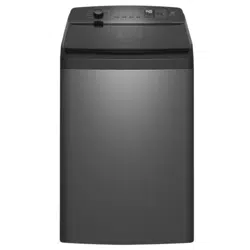Loading ...
Loading ...
Loading ...

23
If you use pre-treatment sprays or stain
removers, apply them to the clothing well
away from your washing machine.
Pre-treatment sprays and stain remover
can damage plastic components on your
washing machine.
WARNING!
Don’t use the wrong type of detergent.
You must use a low sudsing detergent
designed for front load washing
machines or high efficiency top loaders,
such as Cold Power for Front Loaders
and High Efficiency Top Loaders or
detergents labelled “Matic”.
Don’t use soap-based products in your
washing machine.
Don’t use too much detergent. This can
result in excessive suds that can cause
low spin speeds, poor rinsing and
overloading the motor during spin stages
of the wash program.
Don’t use too little detergent because
you will get a poor wash. If you think you
need more, increase dosages by only
small amounts to avoid excessive suds.
Quantity of detergent to be
used
Good washing results also depend on the
choice of detergent and use of the correct
quantities to avoid waste and protect the
environment.
Although biodegradable, detergents
contain substances which, in large
quantities, can upset the delicate balance
of nature.
The choice of detergent will depend on the
type of fabric (delicates, woollens, cottons,
etc.), the colour, washing temperature and
degree of soiling.
The type and quantity of detergent will
depend on the type of fabric, load size,
degree of soiling and hardness of the
water used.
Information on the hardness of the water
in your area can be obtained from the
relevant water supply company, or from
your local authority.
Follow the product manufacturers’
instructions on quantities to use.
Not enough washing powder causes:
the wash load to turn grey, greasy
clothes.
Too much washing powder causes:
sudsing, reduced washing effect,
inadequate rinsing.
Use less detergent if: you are washing
a small load, the laundry is lightly
soiled, and large amounts of foam
form during washing.
Water hardness is classified in so-called
“degrees” of hardness.
Blood: treat fresh stains with cold water.
For dried stains, soak overnight in water
with a special detergent then rub in the
soap and water.
Oil based paint: moisten with benzine
stain remover, lay the garment on a soft
cloth and dab the stain; treat several
times.
Dried grease stains: moisten with
turpentine, lay the garment on a soft
surface and dab the stain with the
fingertips and a cotton cloth.
Stubborn stains may not be removed by
just water and detergent. It is therefore
advisable to treat them prior to washing.
Rust: oxalic acid dissolved in hot water
or a rust removing product used in cold
water. Be careful with rust stains which
are not recent since the cellulose
structure will already have been
damaged and the fabric tends to hole.
Mould stains: treat with bleach, rinse
well (whites and fast coloureds only).
Grass: soap lightly and treat with bleach
(whites and fast coloureds only).
Ballpoint pen and glue: moisten with
acetone (*), lay the garment on a soft
cloth and dab the stain.
Lipstick: moisten with acetone (*) as
above, then treat stains with methylated
spirits. Remove any residual marks from
white fabrics with bleach.
Red wine: soak in water and detergent,
rinse and treat with acetic or citric acid,
then rinse. Treat any residual marks with
bleach.
Ink: depending on the type of ink,
moisten the fabric first with acetone (*),
then with acetic acid; treat any residual
marks on white fabrics with bleach and
then rinse thoroughly.
Tar stains: first treat with stain remover,
methylated spirits or benzine, then rub
with detergent paste.
(*) do not use acetone on artificial silk.
Loading ...
Loading ...
Loading ...
